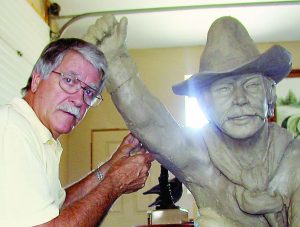By M.V. Moorhead

Most of the time, most of us pay little attention to it. Now and then it might catch our eye, we might spend an idle minute or two reading a plaque, or admiring the craftsmanship of a statute or mosaic. And now and then pieces might get pulled into a public controversy.
Otherwise, we tend to let public art blend into the scenery, like the trees or the buildings; it becomes part of the backdrop of our lives.
Nonetheless, public art, in the form of sculpture and monuments, has been a part of people’s lives, especially in urban areas, since ancient times. And it has often been a source both of civil pride and of civil conflict, both for economic and ideological reasons.
Sculptor Arthur “Art” Norby thinks this is healthy. “It’s good for the psyche to look at art,” says Norby. “Even if you don’t like it, you have to think about why you don’t like it. Or you should.”
Former Tempe Mayor Neil Guiliano famously crusaded for public art during his tenure (1994-2004), championing not only art installations throughout the city but also the founding of the Tempe Center for the Arts. But other cities around the Valley have shown a firm commitment to the muses as well, notably Carefree, Sun City West, Peoria and Mesa, all of which feature sculptures by Norby.
“I’ve probably always been an artist,” says Norby, a native of southwestern rural Minnesota. “Before I was in kindergarten I had an aunt who taught me some artistic things, and all through school I was drawing pictures.”
It wasn’t until after his stint in the Navy and some years in the sporting goods business that Norby decided to pursue art seriously. He was self-taught: “I stole the best ideas and techniques from anywhere I could,” he admits.
Norby’s initial medium was scrimshaw, engraving images on cowbone and deer antlers. As his skills improved, he invested in whale teeth and walrus tusks, and eventually even paid $900 for a mastodon tusk. But he abandoned this traditional form in 1980.
“I knew I didn’t want to be categorized as a wildlife artist,” he notes. “I went right from scrimshaw to sculpture.”
It’s in that form that Norby, who ran the Norby Gallery in Cave Creek from 1996 to 2007 (it’s now based in New London, Minnesota), has had his most notable successes. He started with table-top sized projects: “One of my earliest works was a buffalo, bigger than a cantaloupe, smaller than a watermelon,” he recalls, and his Minnesota Heritage Collection included figures of “farmers, Indians, pioneers.”
From these, Norby moved on to monumentalsized projects like The Walkover, a 1983 commission depicting a gymnast. “It ended up in the collection of an anonymous collector in Seattle who also had a Henry Moore, so I was in good company, although”—he adds with prompt Minnesotan modesty—“I’m not that good.”
Eventually Norby would land public commissions throughout the country, from Windom, Minnesota to Trenton, New Jersey to the statue of Ernest McFarland in Mesa. Unsurprisingly, he’s a supporter of public art.
“I think it’s a necessity,” he says. “We’re in a period where public art is under scrutiny,” referring to the recent protests for and against Civil War memorials. “I don’t personally think that art should be destroyed because it is offensive, although maybe in an area where there’s a lot of dissent against it should be moved to storage, or a museum. But the art itself shouldn’t be destroyed or denigrated.”
As for his own work, Norby claims to be apolitical: “In my art, I’m not for or against abortion, for or against war. I try to make feel-good art. I want you to feel good about what I’ve done.”


